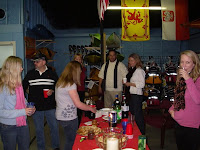 After a busy morning yesterday with Christmas kayakers, the afternoon became quiet at the shop. Imagine my surprise when the door burst open, and there she was! Dr. Lina Lukashevich, in the flesh, walking into Sea Kayak Carolina!
After a busy morning yesterday with Christmas kayakers, the afternoon became quiet at the shop. Imagine my surprise when the door burst open, and there she was! Dr. Lina Lukashevich, in the flesh, walking into Sea Kayak Carolina!"Who is Dr. Lina Lukashevich?" -- you may wonder. She is the author of the recent book Kayak Anna and the Palindrome Creek. It is "...a splashing eco-adventure for readers ages 9 - 13. Anna fights pollution in her neighborhood creek. Along the way she encounters bullies, leeches and alarmingly ravenous trolls!
Lina came to visit from her home town of Brookfield, Illinois! She was in Columbia with her Mom to visit her aunt. They came to tour Charleston and had a chance to drop off some copies of Kayak Anna. They are available here at the shop, or call (843) 225-7969 for a copy to be delivered to your door, or the door of a young reader/kayaker of your choosing. Lina is donating all of her profits to Living Water International, which helps provide clean, safe drinking water to children around the world. Copies of Kayak Anna are $12.99.
Lina may be back to Charleston in April for the East Coast Canoe and Kayak Festival - as part of Sea Kayak Carolina's compound. Keep your fingers crossed!
"And what is a palindrome?" you may wonder. A word spelled that is spelled the same way forwards and backwards. The first to email me an example of a palindrome will win a free SKC Nalgene water bottle with their purchase of Kayak Anna!
Scott@SeaKayakCarolina.com






































